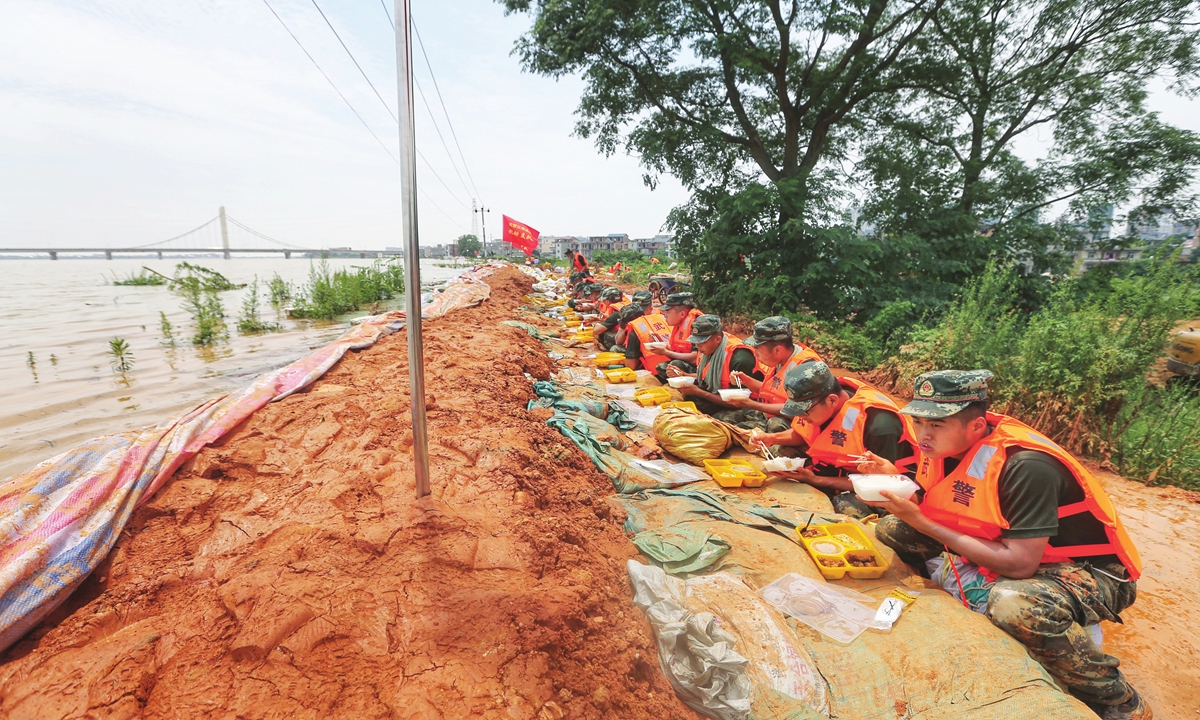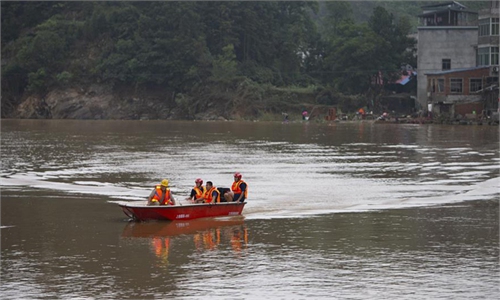Military race against clock before new round of rainfall further strains anti-flood efforts

Armed police soldiers stick to the dyke while eating lunch on Monday. They battled the floods by reinforcing the river banks of Poyang Lake in East China's Jiangxi Province. The lake, China's largest freshwater lake, exceeded the highest-ever recorded water level on Sunday. Photo: Cui Meng/GT
Some 24,000 People's Armed Police (PAP) and PLA troops have joined the efforts to combat floods in hard-hit East China's Jiangxi Province, where 6 million people have been impacted. The military are racing against the clock to repair and consolidate dykes to overcome another round of floods amid upcoming rainfall.
At Poyang county, which is located next to the country's largest freshwater lake of the same name, armed police are repairing soil piping points, consolidating and heightening the dykes to prepare for floods. Behind them were the county center and 400,000 residents.
Xu Lefan, 24, an active member of the PLA Air Force, was on vacation in Jiangxi's capital city Nanchang when he learned about the dangerous situation in Poyang county. Xu immediately bought a high-speed train ticket and rushed to Poyang to join the urgent task of building a "mud wall" on top of previous dykes amid rising water.
"As a PLA member, it's my natural duty to tackle disaster and aid the people," Xu told the Global Times on Tuesday.
Born into a military family, Xu served outside the Leishenshan Hospital in Wuhan, Central China's Hubei Province during the COVID-19 outbreak where her mother, a military doctor, worked.
PLA veteran Liu Shaojun and former PAP member Sun Xinglong learned about the disaster online and volunteered to come to Poyang to join the battle, and were mobilized into the Jiangxi PAP forces.
Chen Zhangjun and Chen Xing, both Jiangxi natives, witnessed the floods in 1998 inundate their homes. They are now in Yongxiu county, Jiujiang, to help evacuate local people, rescue their property and prepare for the flood peak, which is forecast to arrive on Wednesday.
As the enclosure in Yongxiu breached late Sunday night, the two were part of the overnight emergency evacuation mission which had transported 23,411 residents to safety.
"I had little recognition of disaster in 1998, but seeing people's suffering made me sad now. I want to help them as much as possible and none of us complained about the difficulty of the mission," Chen Xing said.
Southern China has seen unusually long monsoon rains, with 433 rivers reporting water levels above warning lines.
China's Changjiang (Yangtze River) Water Resources Commission on Tuesday downgraded the flood alert from red to orange for some sections of the middle and lower reaches of the river amid receding water levels, giving anti-flood workers a short respite.
But on the same day, meteorological authorities issued a blue rainfall alert to upper reaches of the Yangtze River basin as well as the Huaihe River basin, which is north of the Yangtze.
A senior water conservation expert, who requested anonymity, told the Global Times on Tuesday that if the rain belt keeps moving northward in its usual pattern, the Yangtze drainage basin should be safe, as rainfall in the upper reaches can be mediated by the Three Gorges Reservoir.
But the expert also pointed out that the monsoon season will continue for at least another month and abnormal weather will pose uncertainty to flood control efforts.


